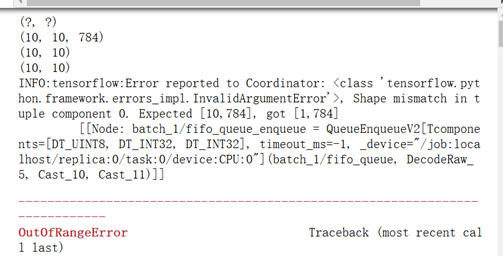将图片数据写入Record文件
# 定义函数转化变量类型。 def _int64_feature(value): return tf.train.Feature(int64_list=tf.train.Int64List(value=[value])) def _bytes_feature(value): return tf.train.Feature(bytes_list=tf.train.BytesList(value=[value])) # 读取mnist数据。 mnist = input_data.read_data_sets("F:/data_of_zengjie/a_minist",dtype=tf.uint8, one_hot=True) images = mnist.train.images labels = mnist.train.labels pixels = images.shape[1] num_examples = mnist.train.num_examples # 输出TFRecord文件的地址。 filename = "./TFRecord_Output/output.tfrecords" if not os.path.exists('./TFRecord_Output/'): os.makedirs('./TFRecord_Output/') writer = tf.python_io.TFRecordWriter(filename) print (num_examples) #for index in range(num_examples): #for index in range(9): for index in range(101): #for index in range(54999): image_raw = images[index].tostring() example = tf.train.Example(features=tf.train.Features(feature={ 'pixels': _int64_feature(pixels), 'label': _int64_feature(np.argmax(labels[index])), 'image_raw': _bytes_feature(image_raw) })) writer.write(example.SerializeToString()) writer.close() print ("TFRecord文件已保存。")
在上面的代码中:通过for index in range(101):
可以控制写入文件的Example数量。
一次读取一个样例
# 读取文件。 reader = tf.TFRecordReader() filename_queue = tf.train.string_input_producer(["./TFRecord_Output/output.tfrecords"]) # 每次读取一个 _,serialized_example = reader.read(filename_queue) features = tf.parse_single_example( serialized_example, features={ 'image_raw':tf.FixedLenFeature([],tf.string), 'pixels':tf.FixedLenFeature([],tf.int64), 'label':tf.FixedLenFeature([],tf.int64) }) images = tf.decode_raw(features['image_raw'],tf.uint8) labels = tf.cast(features['label'],tf.int32) pixels = tf.cast(features['pixels'],tf.int32) sess = tf.Session() # 启动多线程处理输入数据。 coord = tf.train.Coordinator() threads = tf.train.start_queue_runners(sess=sess,coord=coord) for i in range(10): image, label, pixel = sess.run([images, labels, pixels]) print (image.shape,label,pixel) #image是长度为784的数组

一次读取多个样例,
使用read_up_to(注意当前代码所在的方格不要和前面的程序都放在jupyter notebook中运行。否则前面的定义会影响下一个方格代码的执行。最好刷新一下kernel,重新选择某个方格运行。)
注意:从
_,serialized_example = reader.read(filename_queue)
# 解析读取的样例。
features = tf.parse_single_example(
改为
_,serialized_example = reader.read_up_to(filename_queue,10)
# 解析读取的样例。
features = tf.parse_example(
# 读取文件。 reader = tf.TFRecordReader() filename_queue = tf.train.string_input_producer(["./TFRecord_Output/output.tfrecords"]) # 每次读取多个 _,serialized_example = reader.read_up_to(filename_queue,10) # 解析读取的样例。 features = tf.parse_example( serialized_example, features={ 'image_raw':tf.FixedLenFeature([],tf.string), 'pixels':tf.FixedLenFeature([],tf.int64), 'label':tf.FixedLenFeature([],tf.int64) }) images = tf.decode_raw(features['image_raw'],tf.uint8) labels = tf.cast(features['label'],tf.int32) pixels = tf.cast(features['pixels'],tf.int32) print(images.get_shape()) #通过输出,发现是(?,?)也就是无法确定shape。 sess = tf.Session() # 启动多线程处理输入数据。 coord = tf.train.Coordinator() threads = tf.train.start_queue_runners(sess=sess,coord=coord) for i in range(100): image, label, pixel = sess.run([images, labels, pixels]) print(image.shape) print(label.shape)
 、
、
但是有一个问题就是:
第一:假设在一开始写入TFreord的时候,使用的是for index in range(101):
即写入的是101个example,而这里一次读取10个,那么总是会出现某一次为(1,784)的情况。即read_up_to没有为了单次达标10个而循环读取的功能。当文件读到最后的时候,它不会从文件的开头再重新读取,而是直接读1个作为那次read_up_to(10)的结果。但是,还保留了一点比较好的地方就是,这里for i in range(100):100次读取,每次读取10个example(不考虑那种只读1个的情况),明显超出了文件的101个example。但是,read_up_to为了满足全部读取次数,此时会循环读取。也就是说,read_up_to不会为了单次达标多少个example而循环读取,但是会为了读取次数达标,而循环读取。
读取TFRecord文件,每次读取多个,使用的是batch
# 读取文件。 reader = tf.TFRecordReader() filename_queue = tf.train.string_input_producer(["./TFRecord_Output/output.tfrecords"]) # 每次读取多个 _,serialized_example = reader.read(filename_queue) # 解析读取的样例。 features = tf.parse_single_example( serialized_example, features={ 'image_raw':tf.FixedLenFeature([],tf.string), 'pixels':tf.FixedLenFeature([],tf.int64), 'label':tf.FixedLenFeature([],tf.int64) }) images = tf.decode_raw(features['image_raw'],tf.uint8) labels = tf.cast(features['label'],tf.int32) pixels = tf.cast(features['pixels'],tf.int32) print(images.get_shape()) #通过输出,发现是(?,?)也就是无法确定shape。 batch_size = 10 capacity = 1000 + 3 * batch_size #images.set_shape(784,) images.set_shape([784]) labels.set_shape([]) pixels.set_shape([]) image_batch, label_batch, pixel_batch = tf.train.batch( [images, labels, pixels], batch_size=batch_size, capacity=capacity) sess = tf.Session() # 启动多线程处理输入数据。 coord = tf.train.Coordinator() threads = tf.train.start_queue_runners(sess=sess,coord=coord) for i in range(100): image, label, pixel = sess.run([image_batch, label_batch, pixel_batch ]) print(image.shape) print(label.shape)
注意:首先,使用batch必须做到一点:
即用set_shape对tensor等进行指定shape否则会
ValueError: All shapes must be fully defined: [TensorShape([Dimension(None)]), TensorShape([]), TensorShape([])]
其次,batch不同于read_up_to,不仅仅会不断的在文件中循环读取,而且一定会为了凑出batch个数目,而循环。所以,不会像使用read_up_to那样出现(1,784)的那种情况。而是全部是(10,784)的情形。
此外,batch还有一个好处是:
会建立一个最大容量为capacity的队列,即如下图所示:

即最后一部分标出的batch。所以,训练神经网络从Example Queue中取batch的时候,另外一个进程可以同步向队列中添加batch。这样的话,就可以避免IO瓶颈。而如果使用read_up_to,则不能像tf.train.batch一样能够构建一个队列,并且支持训练进程和数据处理进程并行化。()
同时使用batch和read_up_to
# 读取文件。 reader = tf.TFRecordReader() filename_queue = tf.train.string_input_producer(["./TFRecord_Output/output.tfrecords"]) # 每次读取多个 _,serialized_example = reader.read_up_to(filename_queue,10) # 解析读取的样例。 features = tf.parse_example( serialized_example, features={ 'image_raw':tf.FixedLenFeature([],tf.string), 'pixels':tf.FixedLenFeature([],tf.int64), 'label':tf.FixedLenFeature([],tf.int64) }) images = tf.decode_raw(features['image_raw'],tf.uint8) labels = tf.cast(features['label'],tf.int32) pixels = tf.cast(features['pixels'],tf.int32) print(images.get_shape()) #通过输出,发现是(?,?)也就是无法确定shape。 batch_size = 10 capacity = 1000 + 3 * batch_size #images.set_shape(784,) images.set_shape([10,784]) labels.set_shape([10]) pixels.set_shape([10]) image_batch, label_batch, pixel_batch = tf.train.batch( [images, labels, pixels], batch_size=batch_size, capacity=capacity) sess = tf.Session() # 启动多线程处理输入数据。 coord = tf.train.Coordinator() threads = tf.train.start_queue_runners(sess=sess,coord=coord) for i in range(100): #image, label, pixel = sess.run([images, labels, pixels]) image, label, pixel = sess.run([image_batch, label_batch, pixel_batch ]) print(image.shape) print(label.shape)

可以看出101个example。
一个batch是10次,1次又是read_up_to(10),所以,一个batch就读了100个。
接着下一个batch的时候,又调用read_up_to时,只剩下1个了,因此报出expected[10,784],got [1,784]的错误。
但是,我们试探性的直接将read_up_to改为102.也就是一次read_UP_to就超出整个文件包含的example,发现:

所以,read_up_to是文件剩多少,就读多少,然后再一直循环下去。不会说为了凑够102.改为100.输出是:

那么上述报错的原因究竟是什么???
正是因为read_up_to是文件剩余多少,就读多少。但是同时使用batch的情况下,需要set_shape。
此时,文件中101个example,一次batch以后读出10*10个example。下一次batch时,调用read_up_to(10),但是只剩下一个了。于是得到的是[1,784]和set的[10,784]有矛盾。故而报错。